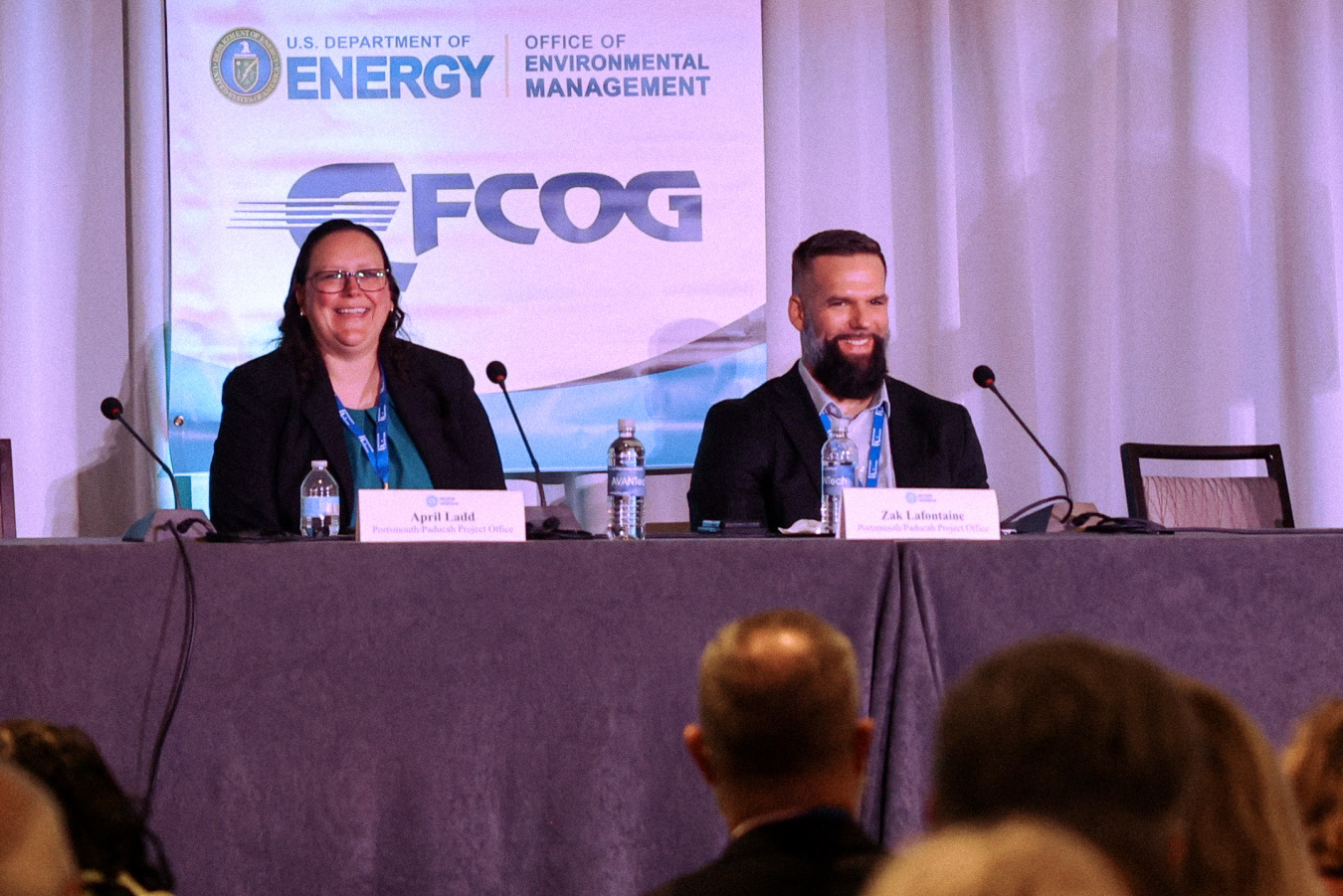As the U.S. Department of Energy Office of Environmental Management works to enable American energy and security, innovative approaches and strong partnerships at the Portsmouth and Paducah sites drive efforts to transform liabilities into assets to help unleash nuclear power.
Office of Environmental Management
September 30, 2025Portsmouth Paducah Project Office Paducah Site Lead April Ladd, left, and Depleted Uranium Hexafluoride Program Manager Zak Lafontaine participate in the panel session, “A New Vision for Paducah and Portsmouth” at the National Cleanup Workshop. The two spoke about how the Portsmouth and Paducah sites are driving efforts to transform liabilities into assets to help unleash nuclear power.
ARLINGTON, Va. — As the U.S. Department of Energy (DOE) Office of Environmental Management (EM) works to enable American energy and security, innovative approaches and strong partnerships at the Portsmouth and Paducah sites drive efforts to transform liabilities into assets to help unleash nuclear power, EM officials, industry representatives and local leaders said here last week at the 2025 National Cleanup Workshop.
“We’re integrating reindustrialization with cleanup to be able to have property and land for transfer sooner,” Portsmouth Paducah Project Office (PPPO) Paducah Site Lead April Ladd said during the “A New Vision for Paducah and Portsmouth” workshop panel session. “If you have reindustrialization going on at the same time as cleanup … workers aren’t working themselves out of a job, they’re working to their next job.”
One of EM’s most significant accomplishments this year was finalizing plans to provide 100 acres of land at the Paducah Site to the nuclear company General Matter for use in building a new uranium enrichment plant. Bruce Wilcox, president and CEO of Greater Paducah Economic Development, noted that General Matter’s project is the largest ever sited in western Kentucky.
“This one project … surpasses the capital investment of all the other projects we’ve done in the past five years,” Wilcox said.
Key to EM’s ability to carry this out, officials said, was use of a leasing process that made it easier to work with private industry and faster to provide the parcel.
“Each step of the lease process we had people expeditiously and effectively getting done what they needed to get done,” General Matter Paducah Program Manager Jantien Shizuru said. “With that lease, we’re planning to execute our vision to restore domestic uranium enrichment capability.”
While it can take a year or two to execute a land transfer, EM and PPPO were able to complete the leasing process with General Matter in approximately four months, said Zak Lafontaine, PPPO Depleted Uranium Hexafluoride (DUF6) Program manager.
Another advantage is the ability for DOE to provide shared services, like security and emergency management, to private firms leasing land.
“It helps everyone to play to their strong suits.” Shizuru said. “Using everyone’s best qualities helped make this project a reality.”
EM is also working to enable reuse of stockpiles of DUF6, a coproduct of former enrichment activities, at the two sites. Already, portions of the stockpile have been identified for private industry, including General Matter and Global Laser Enrichment, to help spur the development of new enrichment capabilities. The National Nuclear Security Administration is also using the material to advance efforts the modernize the U.S. nuclear deterrent.
“We have a pretty sizeable portion of our inventory identified for reuse purposes,” Lafontaine said, adding that reuse can “shave decades off of the lifecycle” for completing disposition of EM’s DUF6 inventory.
A key component of EM’s plans to accelerate cleanup at Paducah is working with federal and state environmental regulators to advance an innovative regulatory approach intended to streamline necessary decision documents. This approach, known as “Decision 2029,” is expected to reduce the number of necessary regulatory documents from 51 to approximately five, Ladd said.
“You’re changing your focus from paper-based documents to a bias for action. You’re using more dollars to efficiently do cleanup,” she said. “Everything is clicking and we’re being able to accelerate and do some pretty cool stuff amazingly quickly.”
Currently, work is focusing on three major regulatory decision documents covering environmental media, facility deactivation and decommissioning, and waste disposal, including a decision on a potential onsite disposal facility, according to Myrna Redfield, program manager with Four Rivers Nuclear Partnership (FRNP), the deactivation and remediation contractor at the Paducah Site.
“The only way we’re going to get there is to look at things differently and work as a team,” Redfield said, praising the extensive communications among FRNP, DOE and federal and state regulators.
Ladd also highlighted EM’s strong partnership with stakeholders around the Paducah Site.
“We’re all in lockstep together,” she said. “It’s amazing when your community is behind you. I think that leads to the success we’ve had at Paducah.”
-Contributors: Jordan Anderson, Sarah Marko, Michael Nartker
To receive the latest news and updates about the Office of Environmental Management, submit your e-mail address.


